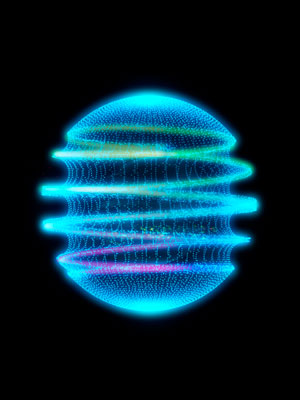Nov 16 2020
Researchers have partially solved the mystery of a hypothetical particle that serves as the solution to one of the biggest puzzles in cosmology.
 An artist’s impression of an axion, a hypothetical elementary particle, which has been invoked to explain why charge–parity symmetry is preserved in quantum chromodynamics. They have since been proposed as a leading candidate for dark matter. Image Credit: Ramon Andrade 3dciencia/Science Photo Library.
An artist’s impression of an axion, a hypothetical elementary particle, which has been invoked to explain why charge–parity symmetry is preserved in quantum chromodynamics. They have since been proposed as a leading candidate for dark matter. Image Credit: Ramon Andrade 3dciencia/Science Photo Library.
A physicist and two colleagues from RIKEN have unraveled the mathematical fundamentals that could elucidate the way so-called axions might produce string-like entities that produce a strange voltage in lab materials.
In the 1970s, axions were first hypothesized by physicists who analyzed the theory of quantum chromodynamics, which explains how certain elementary particles are held together inside the nucleus of an atom.
The problem was that this theory proposed certain strange properties for familiar particles that are not observed. To find a solution to this problem, physicists proposed a new particle—which was later called the axion, after a laundry detergent brand, as it was useful in cleaning up a mess in the theory.
Soon, physicists found that axions could even clear up a cosmic riddle. It is considered that over 80% of the matter in the Universe is formed of an enigmatic invisible substance known as dark matter.
Axions are a candidate for dark matter, but we have not found them yet.
Yoshimasa Hidaka, Interdisciplinary Theoretical and Mathematical Sciences Program, RIKEN
Physicists have been looking for signs of the existence of axions through several experiments as they might exhibit the ideal properties. The XENON1T experiment performed in June 2020 at the Gran Sasso Laboratory in Italy found signs of what could be axions. However, this result is yet to be confirmed.
Yet, there is another domain where the properties of axion can be investigated. Exotic materials dubbed topological insulators can be made by physicists in the lab, which exhibit bizarre properties, such as electricity conduction on their surfaces while acting as electrical insulators from inside. Materials such as these exhibit other unusual behaviors.
At times, their electrons team up together and travel such that the material seems to be formed of “quasiparticles” with strange properties. This can result in an unpredicted voltage across the material, known as the anomalous Hall effect.
Moreover, it is predicted that the axion will arise in this way, in topological insulators, where it must interact with particles of light (i.e. photons), unlike regular particles.
Currently, Hidaka and both his teammates have investigated the theory behind the interaction of photons with axions. Although axions are point-like particles, the researchers estimated that inside materials, light interacts with extended thread-like configurations formed of axions, or axionic strings. That would result in the anomalous Hall effect, which researchers noticed in experiments.
We have found the underlying mathematical structure for the phenomenon.
Yoshimasa Hidaka, Interdisciplinary Theoretical and Mathematical Sciences Program, RIKEN
Journal Reference:
Hidaka, Y., et al. (2020) Higher-form symmetries and 3-group in axion electrodynamics. Physics Letters B. doi.org/10.1016/j.physletb.2020.135672.